This article was originally published in Quilting Quarterly magazine, Winter 2008.
Start with Color
©2008 Ellen Lindner
Color is one of the first things you notice about a quilt. Depending on your preferences, it can either charm you or repel you. Therefore, it makes sense to learn how to use this powerful design element.
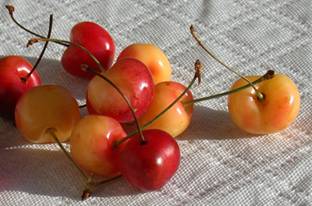
Although there are many useful guidelines for choosing colors, you can find plenty of ideas without learning anything new. Simply look around for inspiration. Notice the colors of nature. Those in a favorite piece of art, or maybe even colors found in the produce section. Pay attention to the proportions of each color, and to how light and dark colors are used. Then, just copy what you see.
Gaining a basic understanding of a color wheel will open many more options for you. Some people are intimidated by a color wheel, but it’s actually pretty easy to understand.
The key point is that each color swatch represents an entire color family. The blue chip, or swatch, depicts EVERY blue: from baby blue to navy, royal blue to country blue. That one chip represents all blues. Therefore, any color guideline that applies to baby blue also applies to every other blue. Note that the blue swatch does NOT portray blue-green or blue-violet, because they are represented by different chips.
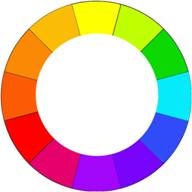
The main reason a color wheel is useful is because of the way it arranges the colors. Although the arrangement is visually pleasing, it’s also scientifically accurate. Red, blue, and yellow – the primary colors – are spaced evenly around the wheel. If two of these colors are mixed, their “offspring” lies half-way between the two parents. Thus, orange is halfway between red and yellow. These mixed colors, orange, violet, and green, are called Secondary colors. In the same fashion, if a primary color and a secondary color are mixed, their offspring will again lie halfway between the two parent colors. The resulting mixtures are called Intermediate colors. They are the ones with double names, like red-orange and blue-green.
Look at yellow, at the top, and violet at the bottom. These colors are visually and scientifically opposite. This is reflected in their opposite positions on the color wheel. They are called complementary. The word complementary comes from the same root as the word complete. Scientifically speaking, these colors complete one another. Whatever is absent in yellow is present in violet, and vice versa. On the other hand, look at yellow and yellow-orange. They are very similar to one another, and it’s no accident that their location on the color wheel is also similar.
People (and animals) perceive different colors as having different temperatures. Some of the colors are considered warm. These are the colors of fire: from yellow through orange and red, and ending with fuscia (red-violet.) The remaining colors are considered cool. They are the colors of nature: from yellow-green, through green and blue, and ending with purple/violet.
Why should you care about temperature? It turns out that it’s both scientifically and artistically pleasing to use mostly cool colors, with warm colors used as accents. The way to remember this is with the phrase “a little bit of fire.” It only takes “a little bit of fire” to get dramatic results. Hopes and Daydreams, below, demonstrates this concept, beautifully. Note: Using primarily cool colors is NOT a rule of any sort, but rather something that’s worthy of your consideration. There are MANY wonderful quilts that don’t follow this guideline.
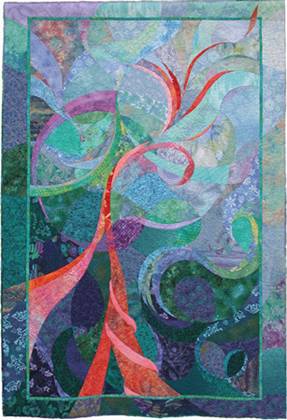
Hopes and Daydreams
Question: What do a key lime pie and a wonderful quilt have in common? Answer: It’s the combination of ingredients that makes them special! My recipe calls for lime juice, sugar, raw eggs, and sweetened condensed milk. Individually those ingredients are not very appealing. But, in combination, they work together to create a fantastic result. And so it is with colors. It’s the combination that’s important.
The most common color combination is complementary (or opposite.) Adding the complementary color always adds drama. See the images below, as an example. First, you see a simple arrangement of 144 blue and white squares.
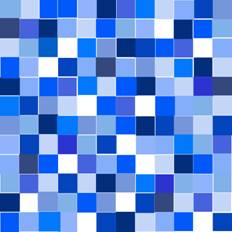
Next, 12 squares of the opposite color, orange, have been added.
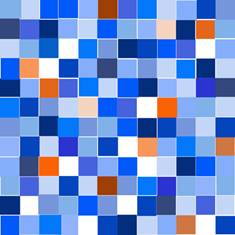
Adding the complementary color
Wow! What a difference that small change has made!
Strong colors were used in the previous example. But remember: there are many other versions of orange and blue. Peach and baby blue are also complementary, as are the combination of rust and navy.
Recognizing that each swatch on the color wheel represents an entire color family, where does your favorite color lie? Sometimes it can be a little tricky to figure this out. Take olive green, for instance. It’s actually a dark version of yellow-green. And, what about rust? It’s a dark version of orange. Neither is very obvious, unless you’ve studied color a little. That’s why, in my color workshops, I have the students purchase an inexpensive artist’s color wheel. On the back side, it shows what happens to the pure colors if white, black, or gray are added. This is very useful when answering the question “What color is it?
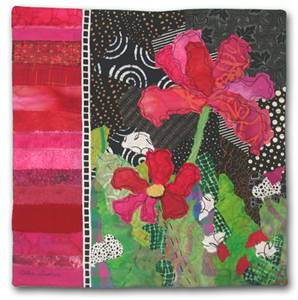
Cosmo Duet
Back to your favorite color. Maybe it’s lime green. What would the complementary color be? Looking at the color wheel, you can see that it would be fuchsia. That’s a strong combination, but one that can be very effective – especially when some neutrals are added. Like Cosmo Duet, above. You could also use toned down versions of these colors, like apple green and berry.
Shifting slightly around the color wheel, we find the Christmas colors of red and green. However, there’s a trick to using these colors. Because they have exactly the same values (levels of lightness/darkness,) a design of only red and green can easily disappear. Barbara Bilbo has very successfully dealt with that in her quilt, Ellen’s Apple, below. She has used a variety of lights and darks to make the design stand out Another option, which is often seen in Christmas quilts, is the addition of another color, such as cream or black. This adds the needed value contrast that is otherwise missing.
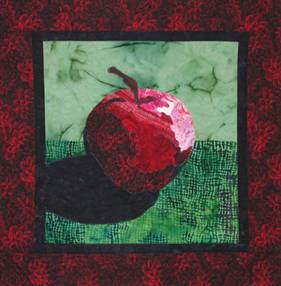
Ellen’s Apple, by Barbara Bilbo
Other complementary pairings include Yellow/Violet, Blue-Green/Red-Orange (like Hopes and Daydreams, page 2,) and Blue-Violet/Yellow-Orange.
There are also many effective variations to complementary color schemes. One is what I call Expanded Complementary. Instead of adding just the complementary color, the colors on either side of it are also added. Out of the Blue, below, is an example. The complement of red-orange is blue. However, blue-green and green have also been included, expanding the palette.
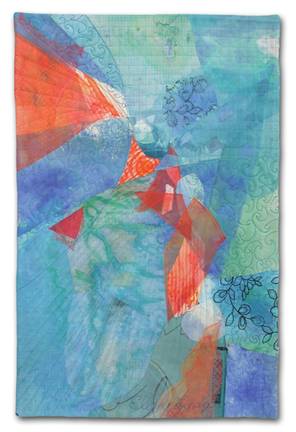
Out of the Blue
Some color combinations are close to complementary, but slightly off. I refer to these as Near Complementary. Linda Matthew’s quilt Blushing Bluebells, below, is a good example. Rather than using the exact complements of red and orange, she has shifted one color slightly, ending up with red-orange and green. A near complementary color scheme, such as this one, is very compelling.
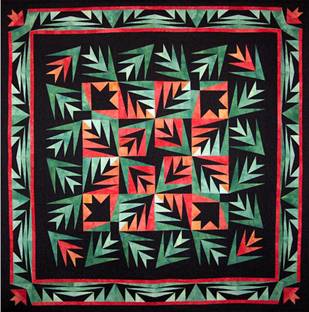
Blushing Bluebells, by Linda Matthews
If we think of the subject of color as a huge iceberg, this article has touched on just the tip of the tip. Still, with a whopping 85% of all design using a complementary color scheme, it’s a concept that will serve you well. You can make a lifetime of wonderful quilts with just this one color guideline! If you have a quilt which seems to need a little something, consider giving it a try.
To think about:
– What (exactly) is your favorite color?
– Where is it located on the color wheel?
– What are some other versions of your favorite?
– What is the (exact) complementary color to your favorite?
– And some lighter and darker versions?
– Is your favorite color warm or cool? How will that affect how you use it?
– Identify other complementary color combinations.
Follow up article: Continue with Color
If you found this information useful, you may be interested in my other free articles, online classes, and e-books. Full directory
